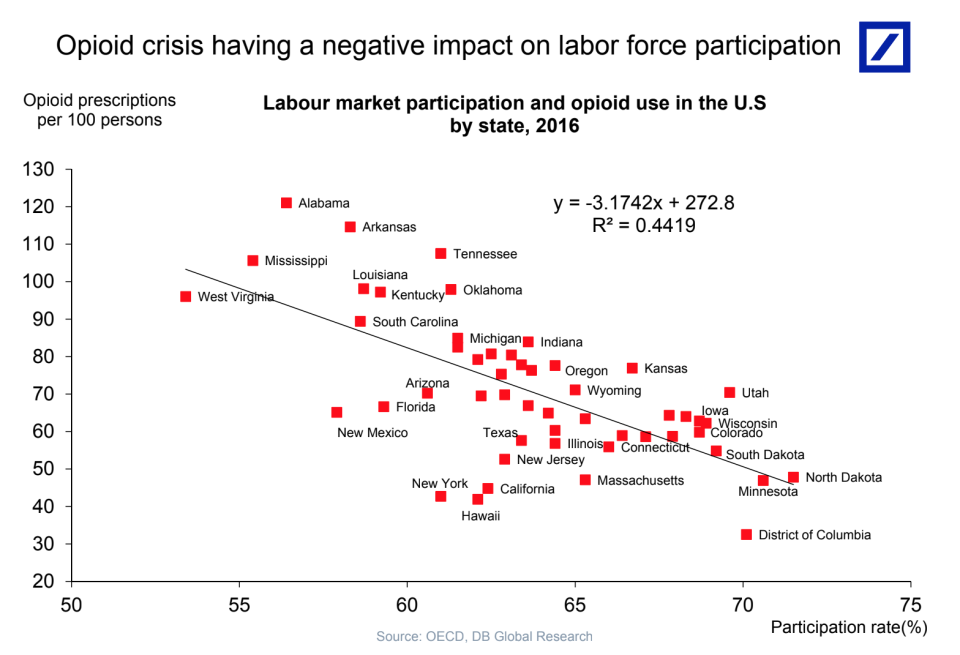Chart: The U.S. opioid crisis is holding back certain states
The opioid crisis appears to be contributing to decreased labor force participation, especially in certain U.S. states, according to a chart by Deutsche Bank’s Torsten Slok.
Opioid use has been one of many driving forces behind higher disability rates, Yahoo Finance previously reported, which leads to more people being out of the labor force (even when the overall economy is humming).
West Virginia, Mississippi, Alabama, and Arkansas are seeing a particularly high correlation between opioid prescriptions and lack of labor market participation, as indicated by this chart:

According to the Bureau of Labor Statistics, the unemployment rate in these states are as follows (as of July 2018): West Virginia, 5.4%; Mississippi, 4.8%; Alabama, 4.1%; Arkansas, 3.7%. The influence of opioid addiction on unemployment — relative to other factors — is not clear.
Earlier this year, research by the University of Tennessee found that “a 10 percent increase in prescriptions [of opioids] causes a 0.56 percentage point reduction in labor force participation.”
Other research, recently published in the Harvard Business Review, found that “while the opioid epidemic has caused wide-reaching devastation, aggregate employment appears not to be one of its victims.”
The Alabama Department of Mental Health, which oversees treatment for substance abuse in the state, refused comment to Yahoo Finance “due to pending litigation.”

‘Opioids impact all components of our society’
In 2016, there were 348 reported drug overdose deaths in Mississippi related to opioids. The state’s per-capita rate of painkiller prescriptions is among the highest in the US.
Dr. Thomas Dobbs, Deputy State Health Officer at the Mississippi Department of Health, believes that a “multifactorial approach” is the best way to tackle the growing problem in his state.
Any solution needs to “incorporate mental health, professional licensure and regulatory authorities, law enforcement, insurance providers, and public health,” Dobbs told Yahoo Finance. “Opioids impact all components of our society.”
Dr. Lindsay Allen, Assistant Professor of Health Economics and Health Policy at West Virginia’s School of Public Health, agrees that there needs to be “a multi-faceted approach to prevention and treatment,” as there is no single reason for the opioid epidemic.
Dr. Allen told Yahoo Finance that opioids’ impact on West Virginia is due to several reasons “combined into a bit of a perfect storm.”

The first, she said, is due to the nature of West Virginia’s economy, which is largely comprised of jobs involving manual labor, such as coal mining. This often leads to work-related injuries and physical pain.
“Then, several years ago, patient satisfaction became an important component of how we measure health care quality,” Allen said. “Clinicians were readily prescribing opioids for pain relief, which contributed to widespread use and dependence.”
‘This starts the cycle all over again’
It doesn’t help that West Virginia’s economy is among the poorest in the country. And, since 2014, it’s had the highest overdose death rate in the country.
So is it drug use that is causing a decline in labor force participation, or a lack of job opportunities leading to people turning to drugs? Dr. Allen believes that it is a little bit of both.
“We know that individuals on Medicaid are more likely to be prescribed opioids and that lower-income individuals are less likely to have access to effective addiction treatment,” he said. “Additionally, being poor and unemployed can be extremely stressful, which also contributes to drug use.”
However, Dr. Allen noted, drug use can also affect one’s chances of getting hired, negatively impact job performance, and/or increase the likelihood of getting hurt on the job.
“This starts the cycle all over again,” she said.
Follow Adriana on Twitter.
Read more: As opioid prescriptions fall, more people should be able to work again

